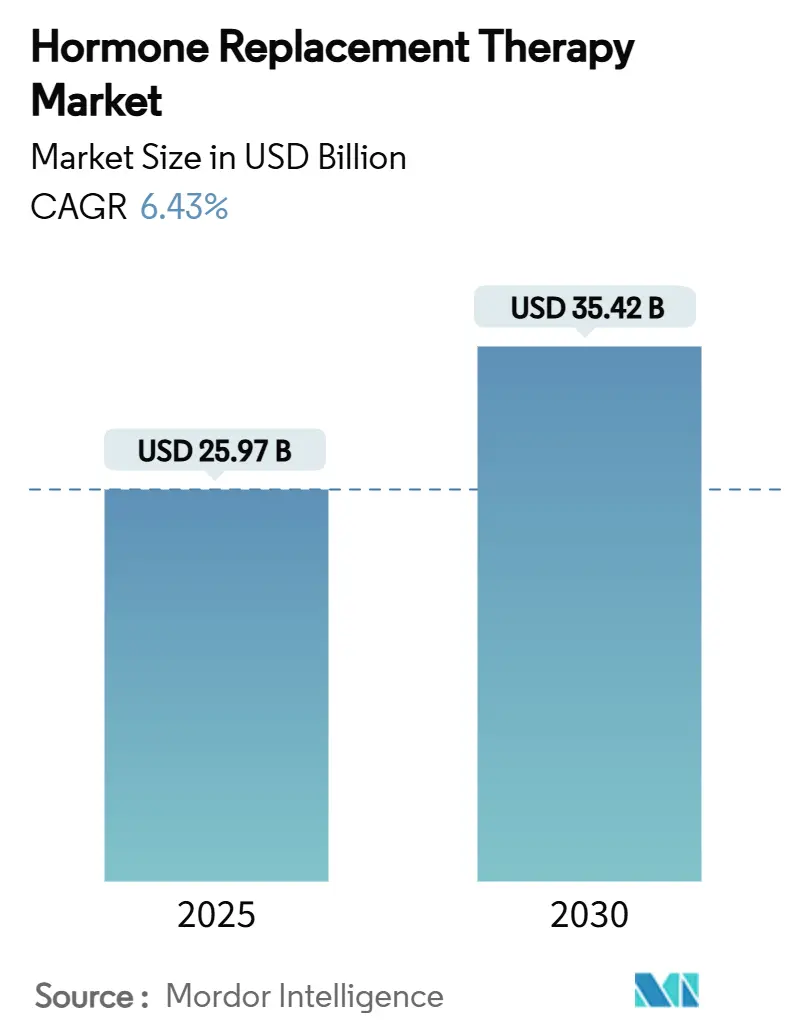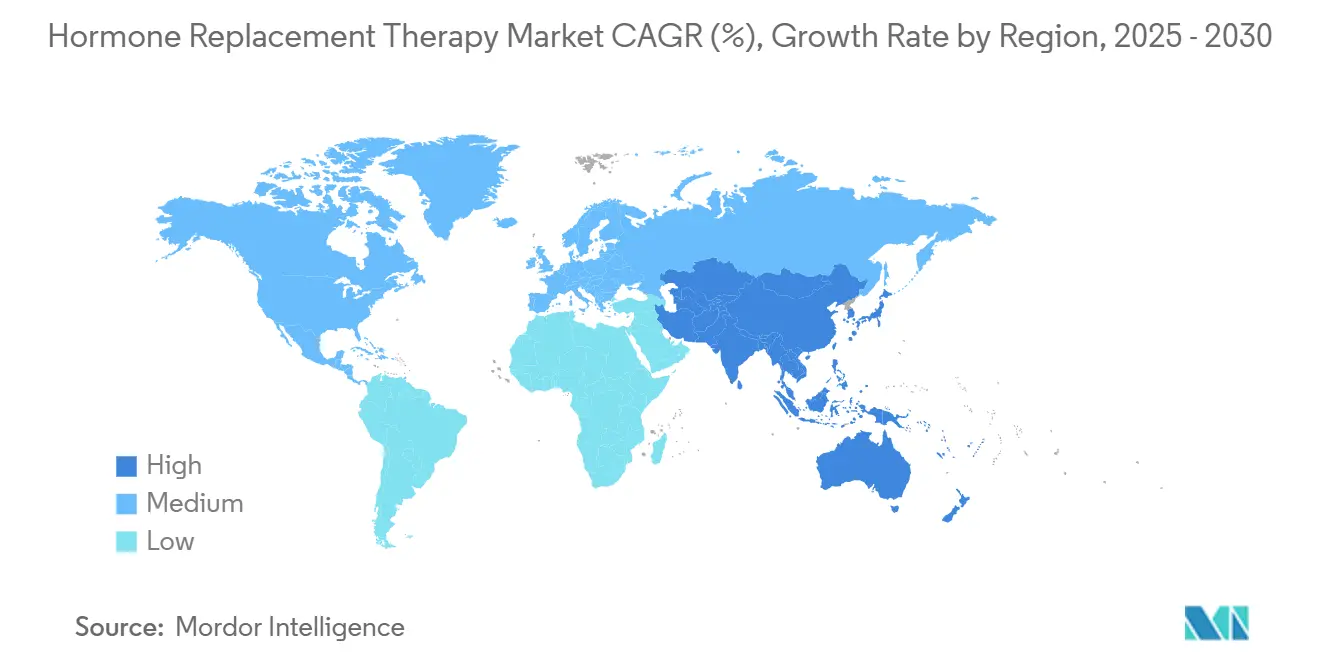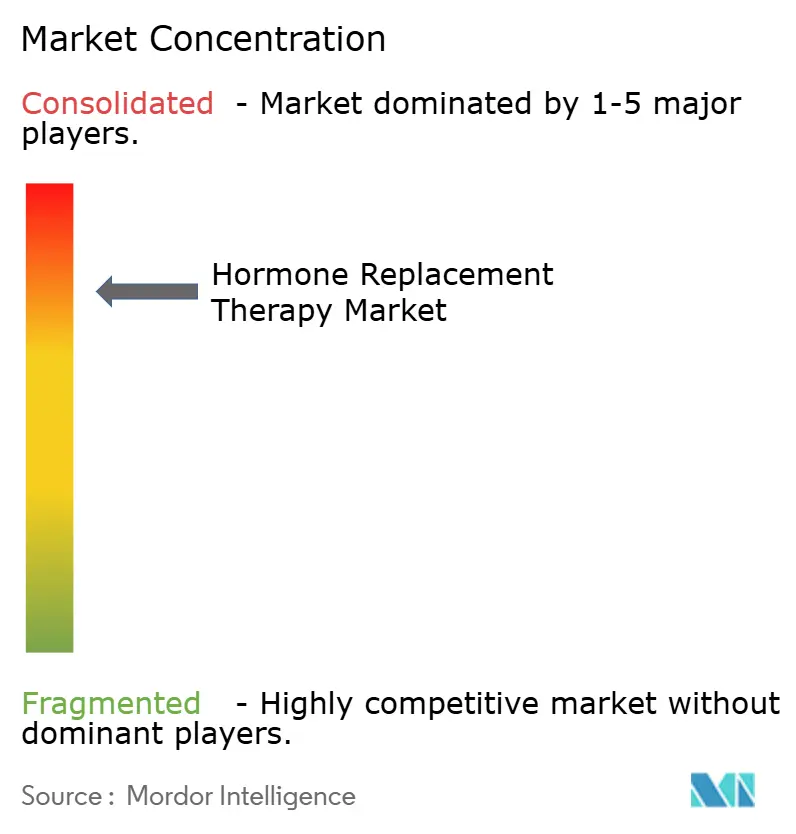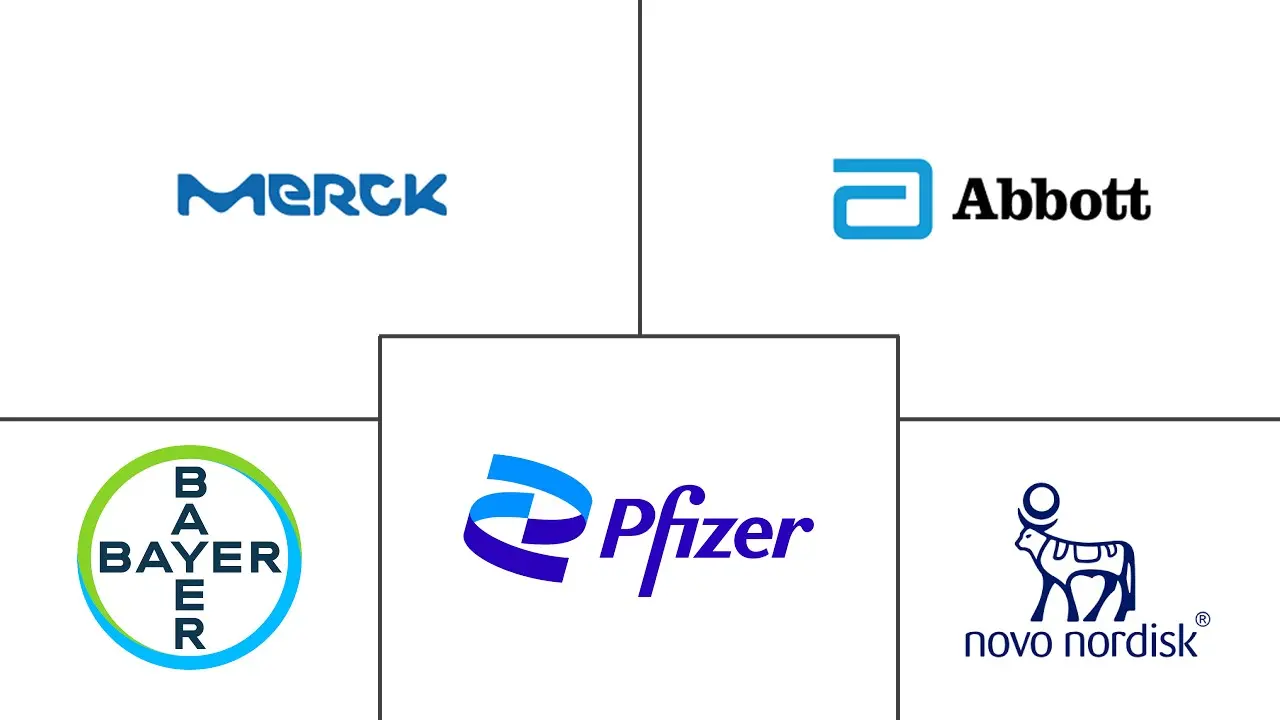Hormone Replacement Therapy Market Size and Share

Hormone Replacement Therapy Market Analysis by Mordor Intelligence
The global hormone replacement therapy market size reached USD 25.97 billion in 2025 and is forecast to rise to USD 35.42 billion by 2030, translating to a 6.43% CAGR. Demand grows in line with an aging demographic—women over 50 are projected to exceed 1.2 billion by 2030. Follow-up findings from the Women’s Health Initiative now distinguish risks across individual formulations, restoring physician confidence and widening candidate pools for treatment[1]Women’s Health Initiative Investigators, “Health Risks and Benefits of Estrogen,” JAMA, jamanetwork.com. Rapid telehealth adoption removes geographic barriers, while direct-to-consumer platforms deliver up to 90% cost savings and accelerate first-time user adoption. Reimbursement pathways keep expanding, as seen in Medicare coverage for medically necessary transgender regimens, which establishes precedents for broader hormonal care reimbursement models. Innovation attention has shifted toward non-hormonal neurokinin antagonists and tissue-selective modulators, positioning the hormone replacement therapy market for sustained mid-single-digit growth despite periodic safety debates and upcoming patent cliffs.
Key Report Takeaways
- By therapy type, estrogen therapies led with 42.56% revenue share in 2024, while parathyroid hormone recorded the fastest 8.51% CAGR forecast through 2030.
- By route of administration, oral delivery held 40.34% of the hormone replacement therapy market share in 2024; transdermal systems are projected to expand at 7.92% CAGR to 2030.
- By indication, menopause accounted for 48.32% share of the hormone replacement therapy market size in 2024, whereas hypoparathyroidism is advancing at a 9.25% CAGR through 2030.
- By distribution channel, hospital pharmacies controlled 52.76% revenue in 2024, yet online/direct-to-consumer channels are growing at 8.73% CAGR between 2025-2030.
- By geography, North America commanded 38.63% share in 2024, and Asia-Pacific is forecast to post the quickest 7.41% CAGR through 2030.
Global Hormone Replacement Therapy Market Trends and Insights
Driver Impact Analysis
| Drivers Impact Analysis | (~) % Impact on CAGR Forecast | Geographic Relevance | Impact Timeline |
|---|---|---|---|
| Surging post-menopausal population | +1.8% | Global, led by Asia-Pacific and North America | Long term (≥ 4 years) |
| Rapid adoption of bio-identical hormones | +1.2% | North America and EU, expanding in Asia-Pacific | Medium term (2-4 years) |
| Tele-health BHRT subscription models | +0.9% | North America core, spill-over to developed markets | Short term (≤ 2 years) |
| Pipeline of micro-dosed & tissue-selective SERMs/SARMs | +0.7% | Global, with early uptake in North America and EU | Long term (≥ 4 years) |
| Wearable transdermal patch innovations & long-acting injectables | +0.6% | Global, with strongest traction in Europe and North America | Medium term (2-4 years) |
| Source: Mordor Intelligence | |||
Surging Post-Menopausal Population & Life-Expectancy Gains
Demographic momentum is enlarging the potential treatment pool as women now spend roughly one-third of their lives post-menopause. Workforce productivity losses, such as Japan’s USD 12 billion annual burden tied to unmanaged menopausal symptoms, nudge healthcare payers and employers toward proactive hormone care programs. Integrated longevity initiatives in public health strategies are creating sustained demand that moves beyond symptom relief toward long-term preventive regimens.
Rapid Adoption of Bio-Identical Hormone Formulations
Clinical evidence shows micronized progesterone and estradiol combinations exhibit lower cardiometabolic and oncologic risk than earlier conjugated equine estrogens, enabling 20-30% premium pricing and faster uptake among health-conscious mid-life women. TherapeuticsMD’s BIJUVA approval set a regulatory benchmark and, with patent protection to 2032, provides a defensible niche for innovators. Capacity expansion through acquisitions, exemplified by Biote’s purchase of 503B compounding facilities, secures supply while standardizing quality.
Expanding Tele-Health BHRT Subscription Models
The HRT Club illustrates how subscription models priced at USD 99 per year can trim overall therapy costs by up to 90%, adding 3,000 members across 42 states within months of launch. Weight-loss providers that already prescribe GLP-1 agents are entering hormone services, leveraging cross-selling opportunities supported by research suggesting enhanced outcomes when the two therapies are combined. Regulators are beginning to draft hybrid oversight requirements to ensure continuity of care.
Pipeline of Micro-Dosed & Tissue-Selective SERMs/SARMs
Late-stage assets such as Bayer’s elinzanetant, a dual neurokinin-1/3 receptor antagonist now under FDA review with a July 2025 decision date, aim to deliver vasomotor relief without systemic estrogen exposure. Parallel development of selective estrogen receptor degraders and modulators promises formulations targeting bone, cognition, and cardiovascular health separately, widening eligible patient sub-groups.
Restraints Impact Analysis
| Restraints Impact Analysis | (~) % Impact on CAGR Forecast | Geographic Relevance | Impact Timeline |
|---|---|---|---|
| Cancer-risk perception post-WHI | -1.1% | North America and EU | Medium term (2-4 years) |
| High lifetime therapy cost & few generics | -0.8% | Global, largest drag in emerging markets | Long term (≥ 4 years) |
| Patent-cliff & pricing pressure on legacy estrogen brands | -0.7% | Global, with highest impact in North America and EU | Medium term (2-4 years) |
| Tightening environmental rules on endocrine-active emissions | -0.5% | EU core, spreading to other regulated markets | Long term (≥ 4 years) |
| Source: Mordor Intelligence | |||
Cancer-Risk Perception After WHI & Follow-Up Studies
Though 21-year follow-up data indicate estrogen-only regimens reduce breast cancer incidence by 23% and mortality by 40%, the original 2002 WHI headlines still shape public opinion. Recent FDA boxed warnings, such as that applied to non-hormonal fezolinetant, keep safety debates visible and complicate physician messaging. Professional societies have updated positions to allow therapy beyond age 65 with individualized counseling, yet broad adoption hinges on continuous educational outreach.
High Lifetime Therapy Cost & Lack of Generic Bio-Identicals
Bio-identical combinations protected until 2032 hold back generic entry and sustain price premiums, limiting affordability in self-pay markets. While Medicare has improved transgender coverage, menopausal regimens still face budgetary hesitation. Direct-pay telehealth partly narrows the gap for affluent users, but lower-income populations in emerging economies remain underserved.
Segment Analysis
By Therapy: Estrogen Dominance Amid Parathyroid Emergence
Estrogen products retained 42.56% of 2024 revenue, underlining their central position in the hormone replacement therapy market. The parathyroid segment, however, is charting an 8.51% CAGR through 2030 as newer indications surface, pushing the hormone replacement therapy market size toward diversified growth corridors. Specialized products such as YORVIPATH for chronic hypoparathyroidism command premium pricing and underscore the shift from broad symptom control to targeted organ support.
Precision-oriented pipelines pair micro-dosed estrogens with tissue-selective modulators to serve nuanced patient profiles. Companies with multi-hormone portfolios are well positioned, whereas single-product players risk share attrition. Testosterone demand is dampened by heightened cardiovascular labeling while growth hormone continues steady uptake among longevity-focused consumers.

Note: Segment shares of all individual segments available upon report purchase
By Route of Administration: Oral Convenience Versus Transdermal Innovation
Oral regimens held 40.34% share in 2024 and remain widely prescribed owing to convenience. Transdermal patches and gels, buoyed by a 7.92% forecast CAGR, offer consistent plasma levels without first-pass metabolism, helping the hormone replacement therapy market transition toward personalized dosing. Novartis’s Estradot micro-patch illustrates how miniaturized systems elevate compliance.
Long-acting injectables such as MIT’s SLIM microcrystal technology hint at quarterly or semi-annual dosing horizons. Vaginal and intrauterine devices continue to address local genitourinary symptoms with minimal systemic exposure, adding breadth to delivery choices.
By Indication: Menopause Dominance Challenged by Specialized Applications
Menopausal symptom treatment represented 48.32% of 2024 turnover, yet hypoparathyroidism’s 9.25% CAGR signals where the hormone replacement therapy market share could rebalance in the coming years. Broader diagnostic adoption for thyroid and growth hormone deficiencies keeps those niches resilient, while policy-driven expansion of gender-affirming care introduces entirely new patient cohorts.
Research exploring hormonal influences on biological aging may lengthen treatment duration, extending profitability per patient. For vasomotor symptoms in cancer survivors, non-hormonal agents under development provide alternatives, widening therapeutic combinations available to oncologists and endocrinologists.

Note: Segment shares of all individual segments available upon report purchase
By Distribution Channel: Hospital Pharmacy Control Faces Digital Disruption
Hospital dispensaries kept 52.76% of revenue in 2024, reflecting ingrained prescribing practices. Online platforms, however, are advancing at an 8.73% CAGR as streamlined onboarding attracts untreated populations, contributing disproportionately to overall hormone replacement therapy market growth. Retail pharmacies occupy a balanced middle ground by coupling walk-in convenience with insurance billing familiarity.
Direct-to-consumer operators leverage artificial intelligence to refine dosage and shipping cadence. Pharmaceutical manufacturers now juggle multichannel rollouts, ensuring quality oversight in telehealth settings while preserving institutional relationships in traditional care settings.
Geography Analysis
North America sustained 38.63% share in 2024 owing to strong reimbursement frameworks, FDA guidance clarity, and an ecosystem that supports rapid telehealth scaling. Medicare’s precedent on gender-affirming coverage signals how policy can unlock new segments. Generic estradiol gel approvals improve affordability, though upcoming patent expiries may pressure established brands.
Asia-Pacific is projected to grow at 7.41% CAGR through 2030. Rising urban incomes, aging populations, and shifting cultural perceptions on women’s health underpin uptake, while corporate Japan quantifies menopause-related absenteeism at USD 12 billion annually, spurring employer-financed wellness offerings[2]Nikkei Asia, “Japan’s USD 12 Billion Menopause Productivity Gap,” asia.nikkei.com. Regulatory pilots in China for gender-affirming therapies and increasing Indian middle-class purchasing power collectively expand the hormone replacement therapy market footprint across the region.
Europe shows steady, guideline-driven demand yet faces cost-effectiveness scrutiny by health technology assessment bodies. Tough environmental rules on endocrine-active emissions influence production costs, with the European Medicines Agency mandating statewide monitoring ema. Emerging regions across the Middle East, Africa, and South America present growth runways but require localization strategies that align with diverse cultural and regulatory landscapes.

Competitive Landscape
Competition centers on differentiated science rather than pure scale. Bayer, Pfizer, Novartis, and other multinationals channel resources into tissue-selective modulators and non-hormonal receptor antagonists, illustrated by Bayer’s elinzanetant, projected as a multi-billion-dollar opportunity pending FDA approval. Mid-tier firms pursue consolidation: Cosette’s USD 430 million purchase of Mayne Pharma’s women’s health assets added 12 patent-protected brands including BIJUVA and IMVEXXY, expanding its reach across oral, vaginal, and combination products[3]Cosette Pharmaceuticals Press Release, “Acquisition of Mayne Pharma Women’s Health Portfolio,” ncbiotech.org.
Start-ups disrupt distribution through subscription telehealth, while biotech innovators employ AI-guided dosage algorithms and advanced polymer patches. Patent cliffs loom over legacy estrogens, freeing room for biosimilar entrants. Companies that integrate diversified delivery technologies with precision formulation pipelines stand best positioned to capture incremental hormone replacement therapy market share as therapy personalization accelerates.
Hormone Replacement Therapy Industry Leaders
Pfizer Inc.
Novo Nordisk A/S
Bayer AG
Abbott Laboratories
Merck KGaA
- *Disclaimer: Major Players sorted in no particular order

Recent Industry Developments
- February 2025: Cosette Pharmaceuticals agreed to acquire Mayne Pharma’s women’s health portfolio for USD 430 million, adding 12 patent-protected hormone products.
- October 2024: FDA approved estradiol gel 0.06%, with clinical trials showing 75% hot-flash reduction in 2-4 weeks.
- September 2024: FDA added a boxed warning to fezolinetant (Veozah) for rare liver injury, elevating safety monitoring requirements.
- August 2024: Bayer submitted the elinzanetant NDA following successful Phase III OASIS studies involving 1,400 postmenopausal women.
- January 2024: Biote Corp acquired Asteria Health, a 503B compounder of bio-identical hormones, enhancing vertical integration.
Research Methodology Framework and Report Scope
Market Definitions and Key Coverage
Our study treats the hormone replacement therapy (HRT) market as all prescription pharmaceutical products that replenish deficient human hormones, primarily estrogen, progesterone, testosterone, thyroid, and recombinant growth hormone, delivered through oral, parenteral, transdermal, vaginal, or implantable routes. According to Mordor Intelligence, aesthetic or over-the-counter nutraceuticals, veterinary hormones, and gender-affirming puberty blockers fall outside this scope.
Scope exclusion: Compounded bio-identical formulations dispensed by specialty compounding pharmacies are excluded because uniform sales auditing is not feasible.
Segmentation Overview
- By Therapy
- Estrogen
- Growth Hormone
- Thyroid
- Testosterone
- Parathyroid
- By Route of Administration
- Oral
- Parenteral
- Transdermal
- Vaginal/Intra-uterine
- Implantable Pellets
- By Indication
- Menopause
- Hypothyroidism
- Growth Hormone Deficiency
- Other Indications
- By Distribution Channel
- Hospital Pharmacy
- Retail Pharmacy
- Online/Direct-to-Consumer Clinics
- Geography
- North America
- United States
- Canada
- Mexico
- Europe
- Germany
- United Kingdom
- France
- Italy
- Spain
- Rest of Europe
- Asia-Pacific
- China
- Japan
- India
- Australia
- South Korea
- Rest of Asia-Pacific
- Middle East & Africa
- GCC
- South Africa
- Rest of Middle East & Africa
- South America
- Brazil
- Argentina
- Rest of South America
- North America
Detailed Research Methodology and Data Validation
Primary Research
Mordor analysts interviewed endocrinologists, gynecologists, specialty pharmacists, and procurement heads across North America, Europe, and Asia-Pacific to refine prevalence assumptions, typical treatment durations, and current ASP bands, and to check stock-keeping-unit splits that seldom surface in public filings.
Desk Research
We began with public datasets that offer dependable baselines, such as FDA drug utilization files, the United Nations' demographic yearbook, and OECD health expenditure tables, which reveal patient pools and spending patterns. Trade bodies, including the International Menopause Society, the Endocrine Society, and the European Thyroid Association, provided prevalence benchmarks and therapy guidelines. Company 10-Ks, investor decks, and clinical-trial registries were mined for pipeline counts and average selling prices (ASPs). Where detailed competitive intelligence was required, analysts consulted D&B Hoovers and Dow Jones Factiva. This list is illustrative rather than exhaustive; numerous additional open and licensed sources informed desk validation.
Market-Sizing & Forecasting
A top-down prevalence-to-treated-cohort build-up furnishes the core estimate, after which supplier roll-ups and channel checks provide bottom-up sense-checks that adjust for parallel imports and cash-pay clinics. Key variables include the proportion of post-menopausal women seeking therapy, testosterone prescription rates per 1,000 men over 45, thyroid disorder incidence, annual average biologic ASP erosion, and regional reimbursement coverage ratios. Multivariate regression, supported by five-year demographic and pricing series, projects demand; scenario analysis then gauges upside from new long-acting injectables.
Data Validation & Update Cycle
Outputs pass two analyst reviews, variance flags trigger back-calls with selected respondents, and models are refreshed each year, with fast updates if major regulatory or safety events occur.
Why Mordor's Hormone Replacement Therapy Baseline Remains Industry's Trusted Benchmark
Published figures differ because firms apply unique scopes, base years, and therapy baskets. Some fold OTC supplements into HRT, while others count only reimbursed prescriptions; currency conversions and update cadence add further drift.
Benchmark comparison
| Market Size | Anonymized source | Primary gap driver |
|---|---|---|
| USD 25.97 B (2025) | Mordor Intelligence | - |
| USD 39.64 B (2025) | Global Consultancy A | Includes compounded formulations and infertility hormones, inflating totals |
| USD 25.17 B (2025) | Trade Journal B | Captures retail pharmacy invoices only, missing hospital-dispensed biologics |
The comparison shows that, by aligning a clearly defined therapy list with dual-track validation, Mordor delivers a balanced, transparent baseline that decision-makers can retrace to published variables and repeatable steps.
Key Questions Answered in the Report
What is the current market size of hormone therapies?
The hormone replacement therapy market size was USD 25.97 billion in 2025 and is projected to reach USD 35.42 billion by 2030.
Which region leads global revenue?
North America held 38.63% of 2024 revenue, supported by favorable reimbursement and robust telehealth infrastructure.
Which therapy type is growing the fastest?
Parathyroid hormone products are forecast to expand at an 8.51% CAGR through 2030 due to broadened clinical use.
How are online platforms influencing access?
Direct-to-consumer services cut costs by up to 90% and are growing at an 8.73% CAGR, reshaping distribution dynamics.
What are the main safety concerns that limit uptake?
Persistent cancer-risk perceptions dating back to early WHI headlines continue to suppress therapy initiation despite new evidence clarifying lower risks for certain formulations.
Which innovation could redefine delivery convenience?
Long-acting injectable microcrystal depots under development at MIT signal a future of quarterly or semi-annual dosing intervals, enhancing adherence.



